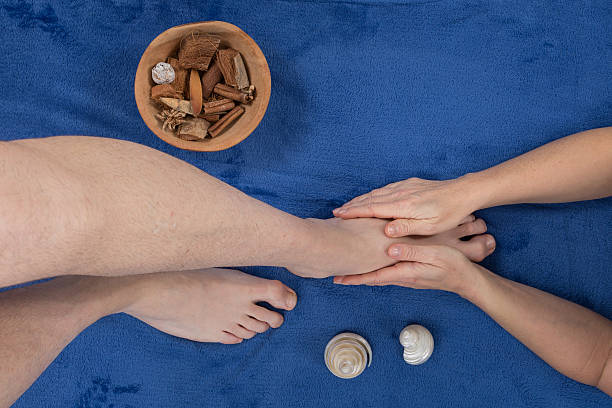Calluses are thickened areas of skin that develop as a result of repeated friction, pressure, or irritation. While they are the body’s way of protecting the skin, calluses can become unsightly and uncomfortable, especially on the feet. Fortunately, there are many DIY solutions that can help soften and remove calluses, leaving your feet smooth and healthy.
In this article, we’ll explore 24 effective DIY remedies for softening calluses on feet, along with tips for preventing them in the future. Plus, we’ve included a helpful FAQ section to answer your most common questions about callus care.
24 DIY Solutions for Softening Calluses on Feet
1. Epsom Salt Soak
Epsom salt helps soften calluses and relax the feet. Dissolve a cup of Epsom salt in warm water and soak your feet for 15-20 minutes.
2. Pumice Stone
A pumice stone is a natural exfoliant that helps remove dead skin. After soaking your feet, gently rub the callused areas with a pumice stone in circular motions.
3. Baking Soda Scrub
Baking soda acts as a gentle exfoliant. Mix three parts baking soda with one part water to create a paste, then scrub the callused areas.
4. Apple Cider Vinegar Soak
Apple cider vinegar helps soften calluses due to its acidic properties. Mix equal parts of apple cider vinegar and warm water, and soak your feet for 15 minutes.
5. Coconut Oil
Coconut oil is a natural moisturizer that helps soften calluses. Massage warm coconut oil into the callused areas and leave it on overnight.
6. Lemon Juice
Lemon juice contains citric acid, which helps break down dead skin. Apply fresh lemon juice to the calluses and leave it on for 10-15 minutes before rinsing.
7. Oatmeal Scrub
Oatmeal is a gentle exfoliant that helps soften calluses. Mix ground oatmeal with honey and milk to create a scrub, then massage it into your feet.
8. Castor Oil
Castor oil is deeply moisturizing and helps soften calluses. Apply castor oil to the callused areas and cover with socks overnight.
9. Tea Tree Oil
Tea tree oil has antifungal and moisturizing properties. Mix a few drops of tea tree oil with a carrier oil (like coconut oil) and apply it to the calluses.
10. Aloe Vera Gel
Aloe vera soothes and softens the skin. Apply fresh aloe vera gel to the callused areas and leave it on for 20-30 minutes.
11. Honey and Milk Soak
Honey and milk are both moisturizing and softening. Mix equal parts of honey and warm milk, and soak your feet for 15-20 minutes.
12. Vaseline
Vaseline creates a protective barrier that locks in moisture. Apply a thick layer of Vaseline to the calluses and cover with socks overnight.
13. Banana Peel
Banana peels contain enzymes that help soften calluses. Rub the inside of a banana peel on the callused areas and leave it on for 10-15 minutes.
14. Rice Flour Scrub
Rice flour is a natural exfoliant. Mix rice flour with honey and apple cider vinegar to create a scrub, then gently massage it into your feet.
15. Shea Butter
Shea butter is rich in vitamins and fatty acids that help soften calluses. Massage shea butter into the callused areas and leave it on overnight.
16. Olive Oil
Olive oil is deeply moisturizing. Warm some olive oil and massage it into the callused areas, then cover with socks overnight.
17. Pineapple Peel
Pineapple peels contain bromelain, an enzyme that helps break down dead skin. Rub the inside of a pineapple peel on the callused areas.
18. Turmeric Paste
Turmeric has anti-inflammatory and exfoliating properties. Mix turmeric powder with water or milk to create a paste, then apply it to the calluses.
19. Mint Leaves
Mint leaves have a cooling effect and help soften calluses. Crush fresh mint leaves and apply the paste to the callused areas.
20. Cornmeal Scrub
Cornmeal is a natural exfoliant. Mix cornmeal with honey and olive oil to create a scrub, then gently massage it into your feet.
21. Vitamin E Oil
Vitamin E oil helps repair and soften the skin. Apply vitamin E oil to the callused areas and leave it on overnight.
22. Chamomile Tea Soak
Chamomile tea has soothing and softening properties. Brew chamomile tea, let it cool, and soak your feet for 15-20 minutes.
23. Glycerin
Glycerin is a humectant that helps retain moisture. Apply glycerin to the callused areas and cover with socks overnight.
24. Warm Water Soak
A simple warm water soak can help soften calluses. Soak your feet in warm water for 15-20 minutes before exfoliating.
Tips for Preventing Calluses on Feet
- Wear comfortable, well-fitting shoes.
- Use cushioned insoles to reduce pressure on your feet.
- Keep your feet moisturized daily.
- Avoid walking barefoot on hard surfaces.
- Regularly exfoliate your feet to remove dead skin.
FAQ About Calluses on Feet
1. What causes calluses on feet?
Calluses are caused by repeated friction, pressure, or irritation, often from ill-fitting shoes or walking barefoot.
2. Are calluses harmful?
Calluses are generally harmless, but they can become painful or cracked if not treated.
3. Can I cut off a callus?
No, cutting off a callus can lead to infection. Instead, soften it with home remedies and gently exfoliate.
4. How long does it take to remove a callus?
It depends on the thickness of the callus, but with consistent treatment, you may see results in a few days to a week.
5. Can calluses come back?
Yes, calluses can return if the underlying cause (like friction or pressure) is not addressed.
6. Are calluses and corns the same?
No, calluses are larger and have a more diffuse edge, while corns are smaller and have a hard center.
7. Can I use a foot file on calluses?
Yes, a foot file can help remove dead skin, but use it gently to avoid damaging healthy skin.
8. Are there medical treatments for calluses?
Yes, a podiatrist can remove calluses using specialized tools or prescribe medicated creams.
9. Can diabetes affect calluses?
Yes, people with diabetes should be cautious with calluses, as they can lead to complications like ulcers.
10. How can I prevent calluses from forming?
Wear proper footwear, moisturize your feet, and address any underlying issues like foot deformities.
Conclusion
Calluses on the feet can be bothersome, but these 24 DIY solutions can help soften and remove them effectively. By incorporating these remedies into your foot care routine and taking preventive measures, you can keep your feet smooth, healthy, and callus-free.
If your calluses are severe or painful, consult a healthcare professional for further treatment. With consistent care, you can enjoy soft, comfortable feet all year round.

